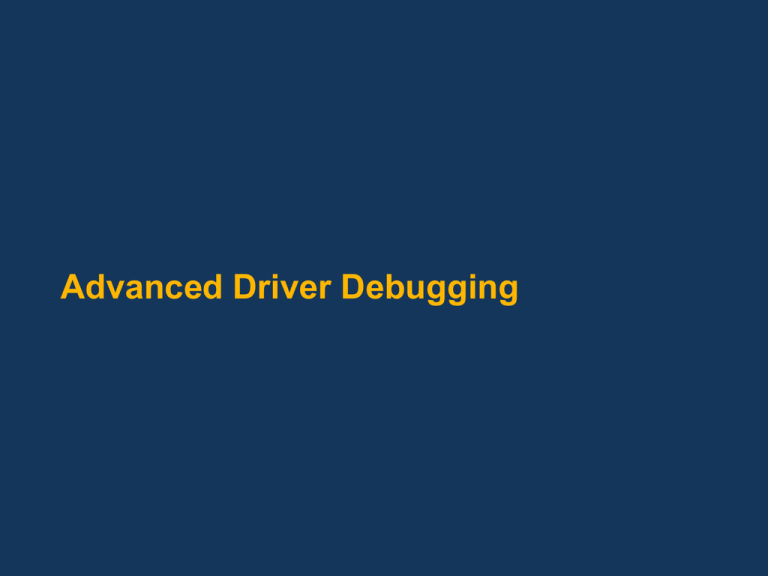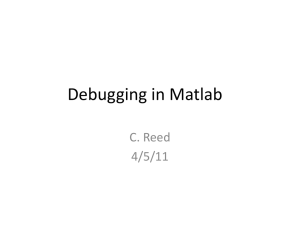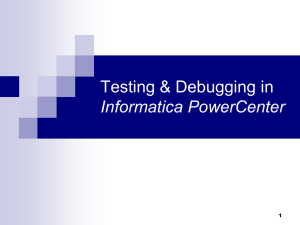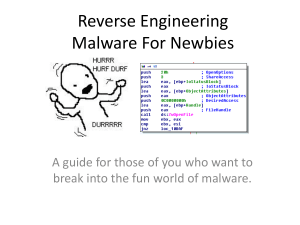
Advanced Driver Debugging
Goals
Debugger overview
Update on Windows Debuggers features
Advanced debugging techniques
Focus on customizing and automating your
debugger experience
Outline
Debugger overview
Symbols
!analyze
Debugger Command Programs
Debugger Extensions
Remote Debugging
Debugger Overview
Documentation
Read the documentation
Installed in the debugger root directory
Reading the docs is key to using the
debugger efficiently
Ever-increasing number of commands and
command parameters
Very large number of debugging topics
No presentation or class can cover all the debugger
features you care about
Use the index for any topic you need more
information on
Use search if the index does not list the topic
New features are also listed on our web site
Types of Debuggers
Command line debuggers
kd.exe: kernel debugger
cdb.exe, ntsd.exe: user mode debugger
WinDbg
GUI on top of kd.exe and cdb.exe
Identical extensions and command interface
Much more efficient for source debugging
Can be slower because of extra data displayed
Dbgrsv.exe, kdsrv.exe, dbengprx.exe
Debugger protocol remoting tools
Discussed later as part of debugger remoting
What Do the Debuggers Support?
Processor architectures:
x86, Itanium, x64
OS versions:
Windows NT 4 and later
No Win9x kernel debugging
Debugging the newest OS requires using the
latest debugger
Protocols
COM, 1394, EXDI, USB 2.0 in beta
Can debug a Windows OS running inside the
Virtual PC or VMware virtual machines
Common Issues
Local variable issues
Turn off compiler optimizations
razzle no_opt
Breakpoint issues
Use the “bu” command to deal with unloading modules
1394 debugging won’t connect
Disable 1394 host controller on the target
COM port debugging won’t connect
Disable legacy USB support in the BIOS
If all else fails, you may have hit a debugger bug
Report it! We don’t release until all known bugs
are fixed.
New Core Debugger Features
New disassembly options
ub: disassemble before the current instruction, handy
for seeing instructions leading up to a return address
uf: disassemble a function based on control flow
Convenient when you want to disassemble an entire function,
displays source line over disassembly to show
source/instruction mappings
Pulls functions that have been split up back into a single
sequential form
New symbol quoting
Resolve symbols with arbitrary text, no more problems
with special characters confusing the evaluator
Specify wildcards in symbol names for easy matching
Specify function arguments in symbols for
disambiguation of overloads
More New Core Debugger Features
p and t can now have command strings to
execute when the step completes
Easy to build conditional stepping similar to
conditional breakpoints
New gc command resumes previous execution in
conditionals so that go/step/trace state is no longer lost
.call command allows retargeting the current
thread to make a specific call in the debuggee
Convenient way to cause arbitrary execution
Automatically builds call frames and handles
return values
Can be dangerous
Currently user-mode x86 and x64 only
More New Core Debugger Features
.fnret displays source-formatted return values for
a function
.printf command provides printf-like
formatted output
Much greater control over output
Naturally handles multiple output values
Extended formats: %y takes an address argument and
displays the symbol for the address. More to come in
the future
Greater flexibility with .shell input and output
Can now spin off commands that the debugger doesn’t
wait for
Can now redirect output of a command to a shelled
process for easy output filtering (redirect to Perl)
More New Core Debugger Features
More string commands
dpa and dpu indirect through memory and display the
strings, like dps for string data. Great for looking at
string tables
s-sa and s-su search for any readable strings in
memory, like strings.exe
New search options
Save search results and research them for refinement
User-mode search for only writable memory instead of
all memory, much faster when searching for
modifiable memory
Output raw search hits as a simple address for
.foreach composition
Symbol sorting options for dv and x
Sort by name or size instead of address, reverse
sort order
More New Core Debugger Features
More flexible typed data handling
Temporary values ($t0-$t19) can now hold
typed information
r? assigns a typed result to an lvalue
r? $t0 = @$peb->ProcessParameters
Assigns a typed value to $t0.
?? @$t0->CommandLine
$t0’s type is remembered so it can be used in further
typed expressions
Many additions for command programs
Greatly expanded alias functionality to provide variablelike behavior
Many new pseudo-registers for programmability
$fnsucc, $ptrsize, $pagesize, $exr_chance, $exr_code,
$exr_param0-14, $extret, $scmp, $sicmp, $spat, $vvalid
New Core Extensions
!address attempts to classify the given address
Intended to be fully general, kind of like !analyze for a
specific address
Determines image vs. stack vs. pool, etc.
Handles both user and kernel mode
Not perfect, still being enhanced
New iterator extensions
Use aliases to pass in lots of info for each step of
the iteration
!for_each_process, !for_each_thread: run a given
command for every process or thread
!for_each_processor: run a command for every
processor in a kernel session
!for_each_module: run a command for every module
New WinDbg Features
Memory windows now auto-fit columns and can
have explicit column control
New memory window display formats for pointer
and symbol (dps-like)
Options for evaluating selected expressions in
source and command output
Scratch pad can now be associated with a file for
automatic persistence
Disassembly window can now display source line
and file info for equating with source and
checking optimizations
More New WinDbg Features
Process attach dialog can now display session
and user name
MRU list for remote connections
Sound notification when idle
Simple command prefix matching in the
command history (like console F8)
Several pre-built workspace “themes” to provide
an initial window layout
Saves hassle of doing an initial window layout
Collected from submissions from real user workspaces
Many others
New Windows Server 2003 Features
Kdbgctrl.exe
Tool to configure the kernel’s debugging options
Run it on the target machine
Change behavior of DbgPrint, user mode int 3,
DbgPrint buffer size, etc.
Upcoming Longhorn Features
Native assert mechanism
Native support for asserts (int 2c)
Debugger can manage asserts more effectively
Kernel error report generation
API to create minidumps without crashing the system
Great for troubleshooting rare problems
Symbols
Symbol Server
Structured storage for symbols and images
Optimized for fast and accurate symbol lookup
Public Microsoft symbol server
http://msdl.microsoft.com/download/symbols
Symbols for all released MS OS binaries
If some files are missing, let us know
Core Microsoft OS images
Needed to debug minidump failures effectively
Can be used from WinDbg and Visual Studio
Symbol Server and Minidumps
Minidumps store the timestamp of images
Debugger uses the file name, timestamp and image
size to map the image
Debugger looks for the symbol file name in the
mapped image
If the wrong image is loaded by the debugger, the
symbols will also be wrong
Storing images and symbols in symbol server is
the best way for the debugger to get the correct
version of the image
Also simplifies archiving of driver versions
IHV and ISV Symbols
Symbols greatly help with the analysis of failures
Don’t lose your symbols!
Sharing symbols with Microsoft
You can submit symbols with driver submissions
to WHQL
On-site vendors can host their own symbol server
Symbol data is stored securely
Sharing symbols is totally optional, but encouraged
Building a Symbol Server
You can build your own symbol server
Take advantage of the Internet symbol server
Symbols downloaded from the internet symbol server
are stored in a symbol server structure
Augment with all of your symbols
Symstore stores symbol files into a symbol server tree
Symstore described in the debugger docs
Store all your symbols in the same location
Everyone can find them
No duplication
Store PDBs and images (.sys, .dll)
Debugging minidumps requires the images
Source Server
New infrastructure to automatically load the
correct version of a source file
Symbol file stores name and version of all source
files used in building the image
Requires building with PDB files
Requires running post build scripts to append source
indexing info to the PDB
Tools shipped with the debugger package
Dependent on the source control system
Supporting additional source control systems only
requires enhancing the tools and build scripts
Symbol Enhancements
symproxy: a symbol server request proxy
Similar to a web server proxy
Allows local caching to reduce load on primary server
Putting a proxy on a bridge server allows symsrv
requests to cross network boundaries
agestore: a new tool to manage local caches
Simple aging and cleanup of locally-stored files
!analyze
What is !analyze?
Debugger extension designed to find root cause
of bugs
Automated analysis
Simplifies analysis of known problems
Understand various states of the OS
Provides good starting point to analyze
complex problems
Extract commonly used debugging information
Results of the analysis are
“Bucket ID”
Unique string representing the bug
An owner for the problem, extracted from triage.ini
In verbose mode
Detailed list of all the data found during the analysis
!analyze Algorithm
Multi-step algorithm
Uses bugcheck, exception or verifier code as
initial input
Can get directly from dump info and can also locate by
stack scanning
Can run in hang analysis mode regardless of the
current state
Does stack analysis
Uses additional data about known problems
provided by developers
Iterates on all the data above to determine the
root cause
Analysis Step One
Use bugcheck or exception parameters to extract
basic information
Each condition is processed by a separate routine that
understands the meaning of each parameter
If specific follow-up or faulting code is found,
report results
Save trap frame, context recording, faulting thread, etc.
Analysis Step Two
Use information in step one to get faulting stack
Scan the stack for special functions such as
Trap0E or UnhandledExceptionFilter to find
alternate stack
Analyze frames on the final stack to determine
most likely culprit
Different weights are assigned to routines
Internal kernel routines have lowest weight
Device drivers have highest weight
Fine grain control provided by triage.ini
Highest weight frame found on the stack is treated as
the culprit
Symbols Make a Difference
Without Symbols
f18e7968 nt!KeBugCheckEx+0x19
f18e7980 nt!IopfCallDriver+0x18
f18e7990 Fastfat!FatSingleAsync+0x74
f18e7a5c Fastfat!FatCommonRead+0x88e
f18e7acc Fastfat!FatFsdRead+0x136
f18e7adc nt!IopfCallDriver+0x31
f18e7b0c SOMEDRV+0x61cb
f18e7b2c nt!IoPageRead+0x19
f18e7b9c nt!MiDispatchFault+0x270
f18e7bec nt!MmAccessFault+0x5b7
f18e7bec nt!_KiTrap0E+0xb8
f18e7cc4 nt!CcMapData+0xef
f18e7cf0 Fastfat!FatReadVolumeFile+0x38
f18e7e78 Fastfat!FatMountVolume+0x1f7
…
BUCKET_ID: 0x35_SOMEDRV+61cb
With Symbols
f18e7968 nt!KeBugCheckEx+0x19
f18e7980 nt!IopfCallDriver+0x18
f18e7990 Fastfat!FatSingleAsync+0x74
f18e7a5c Fastfat!FatCommonRead+0x88e
f18e7acc Fastfat!FatFsdRead+0x136
f18e7adc nt!IopfCallDriver+0x31
f18e7ae8 SOMEDRV!CSymIrp::IrpRead+0x4b
f18e7af8 nt!IopfCallDriver+0x31
f18e7b0c nt!IopPageReadInternal+0xf2
f18e7b2c nt!IoPageRead+0x19
f18e7b9c nt!MiDispatchFault+0x270
f18e7bec nt!MmAccessFault+0x5b7
f18e7bec nt!_KiTrap0E+0xb8
f18e7cc4 nt!CcMapData+0xef
f18e7cf0 Fastfat!FatReadVolumeFile+0x38
f18e7e78 Fastfat!FatMountVolume+0x1f7
…
BUCKET_ID: POOL_CORRUPTION_Foo.sys
Analysis Step Three
If stack does not yield an interesting frame,
analyze raw stack data
Iterate on all stack values using the same
weight algorithm
The ‘dps’ command will show that output
This finds code that corrupts the stack
Analysis Step Four
Check for presence of memory or pool
corrupting drivers
Check for corrupted code streams
Bad RAM
Check for other possible problems, such as
invalid call sequences
Possible CPU problem
Analysis Step Five
Generate final bucket ID and follow-up based on
all gathered information
Determine which fields need to be embedded in the
bucket ID
!analyze assigns ownership of failure
!analyze Enhancements
!analyze is continually being updated to refine
analysis and add new analysis information
New bugchecks and exceptions understood
Other teams are providing app- and domain-specific
analysis
Lots of work being done for automatic hang analysis
If you have suggestions for automatable analysis
send them to pfat @ microsoft.com
Debugger Command Programs
What Is A Debugger Command Program?
A sequence of debugger commands using the
control flow commands for program structure and
aliases as variables
In-between a command script and an extension
Built from normal debugger commands, like a script
Includes iteration and control flow, like an extension
Much simpler than an extension
The price is less flexibility
Not a true programming environment/scripting
model
Aliases are not true variables and can be complicated to use in
complex programs
No execution control allowed in a command program
Control Flow Commands
Basic flow
Looping: .do, .for, .while, .break, .continue
Collection looping: .foreach
Loops for each space-delimited token in a string, command output or
a file
Conditionals: .if, .elsif, .else
Error handling
.catch
.leave
Scoping
.block
Critical for adding a layer of alias expansion
One catch: everything has to be on one line
Special-case with $>< to make script files work reasonably
Alias Enhancements
as now has many options for how to set the replacement
text
/c: from collected command output
/e: from an environment variable
/f: from a file
/ma, /mu, /msa, /msu: from a string in memory
/x: from a numeric expression result
Alias names can now be surrounded by ${<name>} to
allow replacement when embedded within other text
Alias text replacement provides a form of value
substitution that can work like a variable
Can sometimes be complex to get substitution when you want
And not when you don’t want
Extended Alias Replacement Rules
Previously aliases were expanded once when
command processing started
Does not allow for loops to get updated values
Aliases are now expanded for every block
Each layer of { } causes a new alias expansion pass
Passes can be added arbitrarily with .block
Aliases can be block-specific, to give a scope
Aliases replacement with ${/<flag>:<name>}
gives extended control
/v is the most important and protects text from being
replaced, useful for protecting alias names
Several others
More Command Program Commands
aS command takes text just to a semi-colon
$$ comments extend just to a semi-colon,
for embedding
$>< collects lines in a file into a single blob
for processing
$$< and $$>< are forms of $< and $>< which take a file
name up to the new semi-colon
lm and s now have flags to produce results as simple text
for consumption with .foreach
For example, you could use .foreach and s-[1] to write a command
which executes arbitrary operations on every search hit
.foreach ($addr { s-[1]d @esp l80 7ffda000 }) { .printf "Hit at 0x%p\n",
$addr }
Command Program Example
$$ Get module list LIST_ENTRY in $t0.
r? $t0 = &@$peb->Ldr->InLoadOrderModuleList
$$ Iterate over all modules in list.
.for (r? $t1 = *(ntdll!_LDR_DATA_TABLE_ENTRY**)@$t0;
(@$t1 != 0) & (@$t1 != @$t0);
r? $t1 = (ntdll!_LDR_DATA_TABLE_ENTRY*)@$t1->InLoadOrderLinks.Flink)
{
$$ Get base address in $Base.
as /x ${/v:$Base} @@c++(@$t1->DllBase)
$$ Get full name into $Mod.
as /msu ${/v:$Mod} @@c++(&@$t1->FullDllName)
.block
{
.echo ${$Mod} at ${$Base}
}
ad ${/v:$Base}
ad ${/v:$Mod}
}
Command Program Example
$$ Get process list LIST_ENTRY in $t0.
r $t0 = nt!PsActiveProcessHead
$$ Iterate over all processes in list.
.for (r $t1 = poi(@$t0);
(@$t1 != 0) & (@$t1 != @$t0);
r $t1 = poi(@$t1))
{
r? $t2 = #CONTAINING_RECORD(@$t1, nt!_EPROCESS, ActiveProcessLinks);
as /x ${/v:$Proc} @$t2
$$ Get image name into $ImageName.
as /ma ${/v:$ImageName} @@c++(&@$t2->ImageFileName[0])
.block
{
.echo ${$ImageName} at ${$Proc}
}
ad ${/v:$ImageName}
ad ${/v:$Proc}
}
Debugger Command Program Advice
When in doubt, double-check your alias usage
Make sure you’re deleting aliases so that you don’t
have problems with stale values causing replacement
Develop the program as small units and test each
one before composing
Debugger software engineering
If a component doesn’t work, try its commands
by hand
Patience!
At a certain level of complexity write a debugger
extension instead
Debugger Extensions
What Can They Do?
Dump or analyze complex data structures
!process, !devnode, !poolval
Leverages the type information from the PDB file
Simplify routine tasks
!analyze
Automate repetitive steps
Regularly check state of certain objects
Fully control the state of the target
Can write a mini-debugger using the extension APIs
When Should You Write One?
Any task that is repetitive can be sped up by
developing an extension
Allows other people (testers) to help with
basic debugging
Can help identify common problems quickly
To dump internal data structures in a custom
readable format
Avoid writing extensions when:
Code is still fluctuating a lot
Extension must match the code being debugged
Debugger Extension Execution Model
Debugger extensions are routines exported from
a DLL
Calling syntax is
!<module>.<routine> [<params>]
Debugger captures the input
Debugger loads the <module> and calls the
<routine> passing <parameters> as input
Direct function call into the DLL
Extension routine runs on the main
debugger thread
Debugger code takes back control when the
extension returns
Extension APIs
Old APIs in wdbgexts.h
For compatibility with old extensions
Both 32- and 64-bit versions of routines
New APIs in dbgeng.h
Large number of APIs
Provide the full power of the debugger
All 64 bit APIs
Can debug both 32 bit and 64 bit targets
Documentation is partial
We are actively improving it
Upcoming C++ extension framework in the next
debugger package
Greatly simplifies extension development
KnownStructOutput
Different kind of extension entry point that
allows an extension to participate in typed
data formatting
Affects dt, dv, windbg, etc.
Extension provides names of types it
understands
When the debugger is formatting typed data it will
ask the extension to fill a text buffer with a
formatted representation of the type
Similar to built-in handling of LARGE_INTEGER,
UNICODE_STRING and so on
Samples
Numerous samples in the debugger package
Must manually install the SDK component
Building the samples requires the latest
Windows DDK
Overlay the headers and libs from the debugger on top
of the DDK, or follow the readme.txt instructions if you
want to keep the debugger files separate
The extension will run on any OS the debugger runs on
Extensions Must Be Careful
Debugger Extensions run “in-proc”
Debugger has a global exception handler around
extensions to recover from AVs
Heap corruption in an extension will cause the
debugger to crash
Do all target data access through the
debugger APIs
Don't use standard Win32 APIs to try to extract data
from the debug target. The APIs will run locally on the
host and won't be portable with crash dump files.
Extensions must handle Ctrl-Break themselves
Debugger cannot stop extension code
Extension Typed Data Handling Example
// Initialize type read from the address
if (InitTypeRead(Address, _EXCEPTION_RECORD) != 0) {
// Use %p to print pointer values
dprintf("Error in reading _EXCEPTION_RECORD at %p", Address);
} else {
// Read and dump the fields
dprintf("_EXCEPTION_RECORD @ %p\n", Address);
dprintf("\tExceptionCode
: %lx\n",
(ULONG) ReadField(ExceptionCode));
dprintf("\tExceptionAddress
: %p\n",
ReadField(ExceptionAddress));
dprintf("\tExceptionInformation[1] : %I64lx\n",
ReadField(ExceptionInformation[1]));
}
Extension Known Struct Example
if (Flag == DEBUG_KNOWN_STRUCT_GET_SINGLE_LINE_OUTPUT)
{
if (!strcmp(StructName, “_SYSTEMTIME”))
{
SYSTEMTIME Data;
ULONG Ret;
if (ReadMemory(Address, &Data, sizeof(Data), &Ret) && Ret == sizeof(Data))
{
Hr = StringCbPrintf(Buffer, *BufferSize, " { %02ld:%02ld:%02ld %02ld/%02ld/%04ld }",
Data.wHour,
Data.wMinute,
Data.wSecond,
Data.wMonth,
Data.wDay,
Data.wYear);
}
else
{
Hr = E_INVALIDARG;
}
}
else
{
Hr = E_INVALIDARG;
}
}
Remote Debugging
Remote Debugging Definitions
Target
Machine running the code being debugged
Host
Machine running the core debugger, extensions
Host is where symbols are loaded
Remote(s)
Machine(s) connecting to the host
Source code can be loaded on a remote
Process server \ KD connection server
Remotely send data between the host and target
Proxy \ repeater
Machine running a proxy tool, sitting between a remote and a host,
or a host and target
Remote Debugging Connections
For both user and kernel mode
To connect from remote to host
-server on the host ; -remote on the remote
To go through internet proxies using a repeater
Dbengprx.exe
For user mode
Target and host are generally the same machine
To split the host and target
Run dbgsrv.exe on the target machine
Connect the host to the target using –premote option
For kernel mode
Target and host are physically connected (COM)
Run kdsrv.exe on a local host
The host debugger connects remotely to kdsrv
Securing A Remote Session
Secure connections can be established
using SSL
A debugger session can also be secured by
using –secure
Disables the remote user’s ability to tamper with the
host machine
Launch new processes
Change symbol or debugger extension paths
.shell commands, etc
Detailed info in the docs
Other Remote Debugging Issues
Remote.exe
Not related to debugger remoting
Cmd.exe remoting tool
Ntsd –d
Not a remote debugger.
It’s an option to debug user mode applications over the KD
debugger port
‘-d’ only does input\output redirection
Causes lots of problems with symbols
More details in the docs if you need to use it
Call to Action
Get the latest debuggers from
http://www.microsoft.com/whdc/ddk/debugging
Read the debugger docs
Use !analyze
Try and script/program/extend the debugger to
customize your experience
Additional Resources
Debugger issues and requests
windbgfb @ microsoft.com
!analzye questions
pfat @ microsoft.com
Web Resources
Windows Debuggers:
http://www.microsoft.com/whdc/ddk/debugging
© 2005 Microsoft Corporation. All rights reserved.
This presentation is for informational purposes only. Microsoft makes no warranties, express or implied, in this summary.







